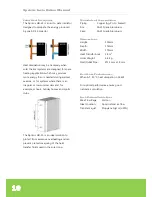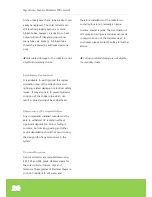
27
If using concrete blocks under the feet,
connecting the blocks together, particularly
front and rear, is advisable as it can help
spread the load. This applies particularly to
the middle legs which are exposed to the
peak loads. Before ballasting the system with
concrete or other weights, be aware of the
total weight live and dead load capacity of
the roof structure and determine if the roof
can safely handle this attachment method.
Other mounting methods in high wind
regions may require inspection and approval
by a licensed engineer or the local building
authority.
NOTE :
It is the responsibility of the installer to
ensure that the frame mounting is of
suitable strength.
✖
Wind related frame and collector damage
is not eligible for warranty claims.
Snow Load
The UK and Ireland as a whole are not
generally considered to be areas prone to
heavy snow falls. However, in areas prone to
heavy or regular snow falls, or where the
accumulation of snow on the collector is of
concern, the solar collectors can be installed
at an angle of 50
o
or greater to promote
snow sliding off the tubes. In addition, it is
advisable to raise the front of the collector
frame 15 to 20cm off the roof surface as this
allows the collector to sit above moderate
snow falls and allow snow to blow away
from under the collector. A front track
extension available from CoolSky can be
used for this purpose.
Each tube is strong enough to withstand
>50kg loading, but roof attachment points
may need to be reinforced. Please refer to
local regulations regarding snow loading
precautions.
✖
Snow loading damage to the collector is
not eligible for warranty claims.
Hail Resistance
The UK and Ireland are not considered to be
areas subject to extreme hail conditions.
The Apricus tubes are manufactured from
robust borosilicate glass and are able to
handle significant impact stresses. Testing
and impact stress modelling shows that the
tubes are able to withstand impact from hail
up to 25 mm in diameter, and even larger
when installed at angle of 45
°
or greater.
In areas prone to hail over 20 mm in
diameter, or where hail impact is of concern,
it is recommended that the solar collector be
installed at an angle of 45
°
or greater to
provide optimum impact resistance.
















































